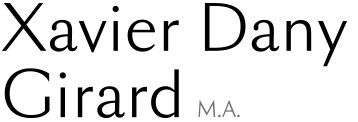Psychotherapy
James F.T. Bugental says in the introduction of his book, The Art of the Psychotherapist: “Art and science are two extremes of the polarity from subjectivity to objectivity…”. Like Bugental, I believe that my challenge as a therapist is to unify those two worlds – combining what you need to be and to know to reach your goals.
I invite you to read the related (french) text down below: “L'homme qui construisait des ponts”.
Psychotherapy services
Couple therapy
Type of difficulties: relationship problems, communication dysfunctions, intimacy troubles, extra-marital relationships, couple growth and adjustment…
LEARNING TOOLS: communication method Listened-Listening, Sensate Focus exercises, the PIC – questionnaire: Perceptions of Intimacy in the Couple©, impact techniques, systemic approach…
Individual therapy
Type of difficulties: emotional difficulties and mental health issues, self-conscious body image, low self-esteem, stress and anxiety, separation, repetition of affective models, mourning, depressive moods, traumas…
LEARNING TOOLS: learning from strength, impact techniques, art therapy, humanistic-existential and phenomenological approach, EMI technique: Eye Movement Integration…
EMI technique
Eye Movement Integration
EMI technique has been elaborated in 1989 by American psychotherapists: Connirae and Steve Andreas. The sources of EMI are the neurolinguistic programming. The method treats the traumas linked to the post-traumatic syndrome but also traumas who do not necessarily fit the strict definition of it. We speak here of disruptive events that have a repetitive and disproportionate impact on someones life (in a specific area of life or on all aspects of it) which are linked to past memories difficult to integrate.* I share with EMI practitioners a concern of efficiency. This is why I integrated this technique to my clinical psychotherapy interventions.
Type of difficulties: “ …any experience that leaves an imprint which generates recurrent and negative effects on one or more levels: cognitive, emotional and sensory”.*
Art therapy
When knowing how to draw is not required
During two semesters (2000-2001) of my Masters in “thérapie par les arts” at Concordia University, I discovered the name of the form of art I was practicing since I was eighteen years old: Phenomenology. With this and the knowledge I had gathered from my clinical studies, I was able to combine art and therapy. The technic I offer consist of discovering different art mediums, using of creativity, focusing on the present and being open-minded.
Type of difficulties: social, emotional and relational difficulties, self esteem and self image consciousness, personal growth, family conflicts, abuses and any situation or problem where using visual art is the best solving method.

